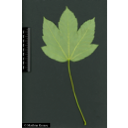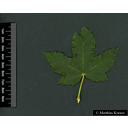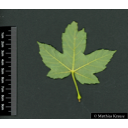Wissenswertes zum Taxon (Art, Unterart, Varietät...)
Acer pseudoplatanus L. 1753
Sapindaceae
(APG IV)sycamore maple, sycamore
Taxon concept: Schmeil-Fitschen 2019
Distribution: Europe without the British Isles and Scandinavia; Turkey, Caucasus
Size: 15 - 30 (m)
Flowering period: V - VI
Acer pseudoplatanus L. - Accepted: Acer pseudoplatanus L. bei The Plant List (2010); Familie: Sapindaceae (APG III)Acer pseudoplatanus L. - Accepted: Acer pseudoplatanus L. bei Zander 2008; Familie: Aceraceae (Zander 2008)Acer pseudoplatanus L. - Accepted: Acer pseudoplatanus L. bei The Plant List (2014), version 1.1; Familie: Sapindaceae (APG III)Acer pseudoplatanus L. - Accepted: Acer pseudoplatanus L. bei BfN Checklist Flora DE; Familie: Sapindaceae (APG IV)Acer pseudoplatanus L. - Accepted: Acer pseudoplatanus L. bei The Plant List (2014), version 1.1; Familie: Sapindaceae (APG IV)Acer pseudoplatanus L. - Accepted: Acer pseudoplatanus L. bei The Plant List (2010); Familie: Sapindaceae (APG IV)Acer pseudoplatanus L. - Accepted: Acer pseudoplatanus L. bei Rothmaler 2017; Familie: Sapindaceae (APG IV)Acer pseudoplatanus L. - Accepted: Acer pseudoplatanus L. bei World Flora Online - APG IV (Angiosperms); Familie: Sapindaceae (World Flora Online - APG IV (Angiosperms))
- Color of flower
- yellowish green
- Flowers
- monoecious, flowers in hanging racemes
- Flower ecology
- insect-pollinated (entomophilous)
- Life form
- woody, tree
- Leaves
- opposite, palmately lobed
- Foliage persistence
- deciduous
- Fruits
- winged nut (samara)
- Fruit ecology
- wind-dispersed (anemochorous)
- Soil conditions
- on perculating fresh to moist, nutrient-rich and alkaline, mildly to moderately acidic, loose, humus-rich, stony, medium to deep loam or scree soils
- Light conditions
- shade to semi-shade plant
- Root type
- deep-rooted plant
- Succession type
- pioneer species
- Natural occurrence (habitat)
- ravine forests, montane forests, moist slip-off slopes, steep rocky slopes, also in floodplain forests
- Comment to ecology
- soil stabiliser
- Status of alien naturalisation
- indigenous
- Usage
- wood is used for making furniture, for turnery, joinery, indoor flooring and musical instruments
- Phytopathogenic organisms
- leaves may be severely affected by several ascomycete fungi such as Pleuroceras pseudoplatani
Bundesamt für Naturschutz (BfN) (1999-2001 and ongoing): Floraweb - Daten und Informationen zu Wildpflanzen und zur Vegetation Deutschlands. www.floraweb.de.; Erhardt, W., Götz, E., Bödeker, N. & Seybold, S. (2008): Der große Zander. Enzyklopädie der Pflanzennamen. Band 2. Arten und Sorten. Eugen Ulmer KG, Stuttgart (Hohenheim), 18. Aufl., 2103 S.; Haider, M. et al. (2005): Wildbienenkataster. See: https://www.wildbienen-kataster.de; Jäger, E. J. et al. (2007): Rothmaler - Exkursionsflora von Deutschland. Band 5: Krautige Zier- und Nutzpflanzen. Spektrum Akademischer Verlag, Aufl. 31.10.2007: 880.; Kämper, Wiebke et al. (2018): Flower visitation honeybee and bumblebee. See: https://www.bexis.uni-jena.de/ddm/data/Showdata/16086?version=2; Maurizio, Anna et al. (1982): Nektar und Pollen - die wichtigsten Nahrungsquellen der Honigbiene. 4. Ehrenwirth, München, 3, überabeitete Auflage; Parolly, G. et al. (2019): Schmeil-Fitschen: Die Flora Deutschlands und angrenzender Länder.. Quelle & Meyer Verlag, Wiebelsheim, 97. Aufl.; Parreno, Alejandra et al. (2025): Visitation records of bees in Germany (58 plots). See: https://www.bexis.uni-jena.de/ddm/data/Showdata/31131?version=12; Pritsch, Günter et al. (1985): Bienenweide.. Neumann-Neudamm, Melsungen; Pritsch, Günter et al. (2007): 200 Trachtpflanzen erkennen und bewerten.. Kosmos, Stuttgart; Ruppertshofen, Heinz et al. (1995): Der summende Wald - Waldimkerei und Waldhygiene.. Ehrenwirth, München, 8., völlig neubearb. und erw. Aufl.; Schick, B. & Spürgin, A. (1997): Die Bienenweide. Eugen Ulmer Verlag, Stuttgart, Auflage: 4., völlig neubearb. u. erw. A., 216 S. 978-3800174188.; Smart, L. B. et al. (2005): Genetic improvement of shrub willow (Salix spp.) crops for bioenergy and environmental applications in the United States. Unasylva, 56: 51-55.; The IUCN Red List of Threatened Species. www.iucnredlist.org; Werle, Susanne et al. (2015): ITS2 DNA metabarcoding of wild bee pollen loads, collected in 2020 and 2021 across all three exploratories. See: https://www.bexis.uni-jena.de/ddm/data/Showdata/31545?version=6; Westrich, P. et al. (2018): Die Wildbienen Deutschlands.. Ulmer Verlag ISBN 978-8186-0123-2.;
Diese Webseite verwendet Google Maps, um Karten und Standorte von Pflanzen in den Hohenheimer Gärten anzuzeigen. Dadurch werden unter Umständen Daten an Google weitergeleitet, was mit einer Verarbeitung Ihrer personenbezogenen Daten verbunden sein kann. Die Datenschutzerklärung von Google finden Sie hier: Datenschutzerklärung von Google
| Locality | Datum (ISO) | Agent | Lat. | Long. | Projekt |
|---|---|---|---|---|---|
| Hohenheimer Gärten | 2013-06-15 | Böcker, Kondraskov, Rosenbauer, Schütz | 0 | 0 | Tag der Artenvielfalt 2013 |
| Hohenheimer Gärten – Schlosspark27 | 2021-05-28 | Nathalie Hund | 48,71063 | 9,21321 | Bachelorarbeit |
| Hohenheimer Gärten – Schlosspark32 | 2021-05-28 | Nathalie Hund | 48,71088 | 9,21497 | Bachelorarbeit |
| Hohenheimer Gärten – Schlosspark35 | 2021-05-28 | Nathalie Hund | 48,71109 | 9,21573 | Bachelorarbeit |
| Hohenheimer Gärten – Schlosspark39 | 2021-05-31 | Nathalie Hund | 48,71127 | 9,2163 | Bachelorarbeit |
| Hohenheimer Gärten – Schlosspark6 | 2021-06-17 | Nathalie Hund | 48,71118 | 9,21173 | Bachelorarbeit |
| Hohenheimer Gärten – Schlosspark7 | 2021-06-17 | Nathalie Hund | 48,711 | 9,2118 | Bachelorarbeit |
| Hohenheimer Gärten – Schlosspark24 | 2021-06-18 | Nathalie Hund | 48,71076 | 9,21371 | Bachelorarbeit |
| Hohenheimer Gärten – Schlosspark28 | 2021-06-18 | Nathalie Hund | 48,71058 | 9,2136 | Bachelorarbeit |
| Hohenheimer Gärten – Schlosspark36 | 2021-06-23 | Nathalie Hund | 48,71099 | 9,21553 | Bachelorarbeit |
| Hohenheimer Gärten – Schlosspark38 | 2021-06-23 | Nathalie Hund | 48,71122 | 9,21616 | Bachelorarbeit |
| Hohenheimer Gärten – Schlosspark40 | 2021-06-23 | Nathalie Hund | 48,71147 | 9,2164 | Bachelorarbeit |
| Hohenheimer Gärten – Schlosspark41 | 2021-06-23 | Nathalie Hund | 48,71159 | 9,21656 | Bachelorarbeit |
| Hohenheimer Gärten – Schlosspark42 | 2021-06-23 | Nathalie Hund | 48,71168 | 9,21656 | Bachelorarbeit |




